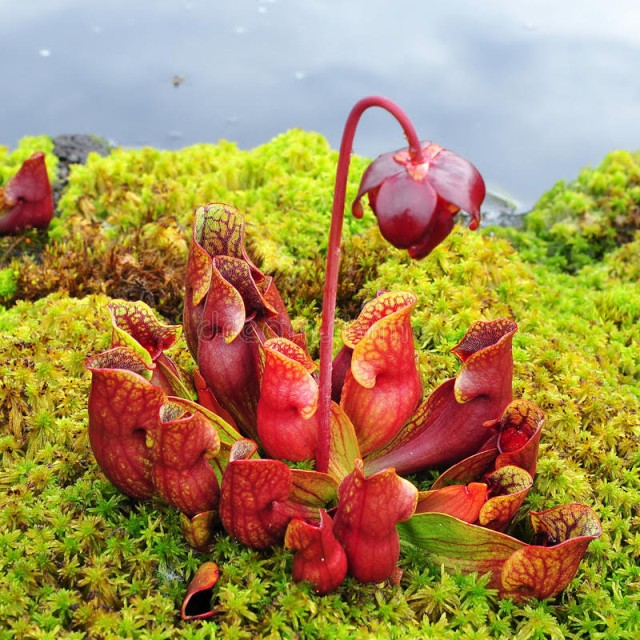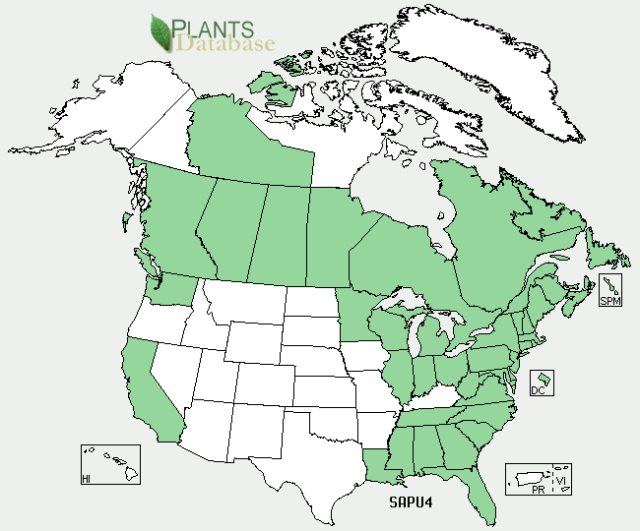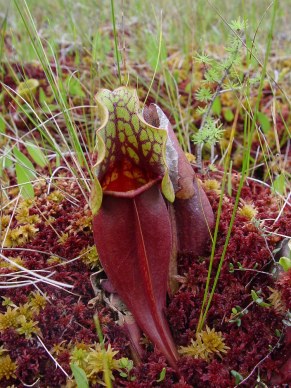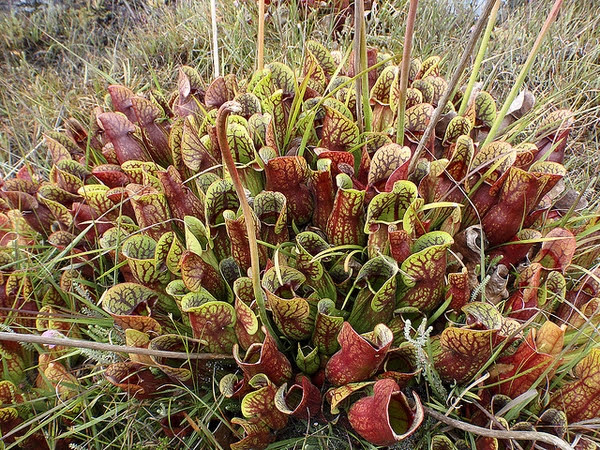
From: https://www.dreamstime.com/stock-photo-sarracenia-purpurea-ssp-venosa-var-burkii-image44003749
Sarracenia purpurea
(Purple Pitcher-plant, Northern Pitcher-plant, Decumbent Pitcher-plant, Pitcher-plant)
Sarracenia purpurea is a pitcher plant, as its common name Purple Pitcher-plant suggests. It is the only member of the Sarraceniaceae family native to Minnesota. Outside of Minnesota, this plant can widely be found throughout Canada and the U.S. Within its native range, the Purple Pitcher-plant is threatened in Florida and Maryland and endangered in Georgia and Illinois.

Native Range of Sarracenia purpurea from: https://plants.usda.gov/core/profile?symbol=sapu4
If you’ve seen this plant outside of a greenhouse, it was likely growing atop sphagnum moss in a wet, squishy bog. Bogs are wetlands in which the majority of their water input comes from precipitation. Marked by minimal water flow, acidic soils, and a build-up of peat, these bogs are very nutrient limited. To survive in such nutrient-poor environments, the Purple Pitcher-plant has turned to carnivory.
General Characteristics
 This perennial plant only grows around 1 to 2 feet high. Its height is due to the long flowering stalks that raise high above the Purple Pitcher-plant’s base. This spatial separation is likely present in order to protect their would-be pollinators from becoming a meal. There is only one nodding flower at the end each stalk, formed from 5 sepals and 5 petals. The 5 broad sepals are red to purple in color and form an umbrella-like structure over the petals. Their pointed ends guide insects to the true flower between the sepals. The true flower is formed from 5 red to purple oval petals. These petals are fleeting during the blooming season from May to August, but the rest of the flower persists till the next growing season.
This perennial plant only grows around 1 to 2 feet high. Its height is due to the long flowering stalks that raise high above the Purple Pitcher-plant’s base. This spatial separation is likely present in order to protect their would-be pollinators from becoming a meal. There is only one nodding flower at the end each stalk, formed from 5 sepals and 5 petals. The 5 broad sepals are red to purple in color and form an umbrella-like structure over the petals. Their pointed ends guide insects to the true flower between the sepals. The true flower is formed from 5 red to purple oval petals. These petals are fleeting during the blooming season from May to August, but the rest of the flower persists till the next growing season.


Equally, if not more distinctive, is the pitcher base of the plant formed from modified leaves. These leaves form tubular structures around 6 to 8 inches long that end in a frilly, roughly triangular lid. This lid shape distinguishes Sarracenia purpurea from other species in the Sarracenia genus. These tubular leaves are often green with purple veining that turn a dark red to purple as the growing season progresses.
The Purple Pitcher-plant can reproduce both sexually and asexually. When sexually reproducing, this plant forms a round, dry capsule fruit that splits open after ripening. The brown seeds inside are covered in tiny knobs that assist in long-distance dispersal. The Purple Pitcher-plant asexually reproduces through vegetative shoots, so that it is often seen in small colonies.

From: https://plants.ces.ncsu.edu/plants/all/sarracenia-purpurea/
Carnivory
In order to survive in low-nutrient bogs, the Purple Pitcher-plant supplements its diet with insects. The pitcher plant practices a passive carnivory strategy, attracting bugs to their watery doom. To accomplish this, the Purple Pitcher-plant employes unique coloring and nectar lures. The reddish markings on the Purple Pitcher-plant are attractive to some insects, such as carrion flies, and also contrast greatly with the other green vegetation typically inhabiting bogs, making them easier for insects to see from further distances. Their most ubiquitous lure, however, is the extra-floral nectaries located along the upper interior and rim of each leaf. These nectaries offer their prey one last meal before their demise.
Once an insect has reached one of Purple Pitcher-plant’s tubular leaves they encounter the downward-pointing hairs that run along these leaves from base to tips. The orientation of these hairs encourages insects to walk down the tube while simultaneously inhibiting them from climbing back out.
At the base of each pitcher leaf lies a liquid pool made from a mix of rainwater and digestive enzymes. Insects drown in these pools and are then broken down into water-soluble nutrients. These nutrients are then absorbed by the plant through specialized cells located at the base of each pitcher.
Other Animal Associations
Though their most well-known animal association is their carnivorous relationship with insects, the Purple Pitcher-plant has other important relationships with animals. In order to sexually reproduce, the Purple Pitcher-plant requires the aid of pollinators such as bumblebees and the pitcher-plant fly (Fletcherimyia fletcheri).
Despite its carnivorous nature, some insects have adapted to live in the deadly pool at the base of each pitcher. The larvae of the pitcher-plant fly, pitcher-plant midge (Metriocnemus knabi), and Pitcher plant mosquito (Wyeomyia smithii) all benefit from the from the nutritious liquid without turning into food themselves.
The Purple Pitcher-plant has its fair share of herbivores. Two moth larvae are specially adapted to only feed on species within the Sarracenia genus. The epauletted pitcher-plant moth (Exyra fax) feeds on the inner surface of tubular leaves and the pitcher-plant borer moth (Papaipema appassionata) feeds on the roots of Sarracenia plants. The dull-barred endothenia (Endothenia hebesana) feeds within the seed capsules of Purple-pitcher plants.
Sources
https://plants.usda.gov/core/profile?symbol=sapu4
https://www.minnesotawildflowers.info/flower/purple-pitcher-plant
https://botany.org/Carnivorous_Plants/Sarracenia_purpurea.php
http://www.illinoiswildflowers.info/wetland/plants/pitcher_plant.htm
http://www.missouribotanicalgarden.org/PlantFinder/PlantFinderDetails.aspx?taxonid=291982&isprofile=0&
